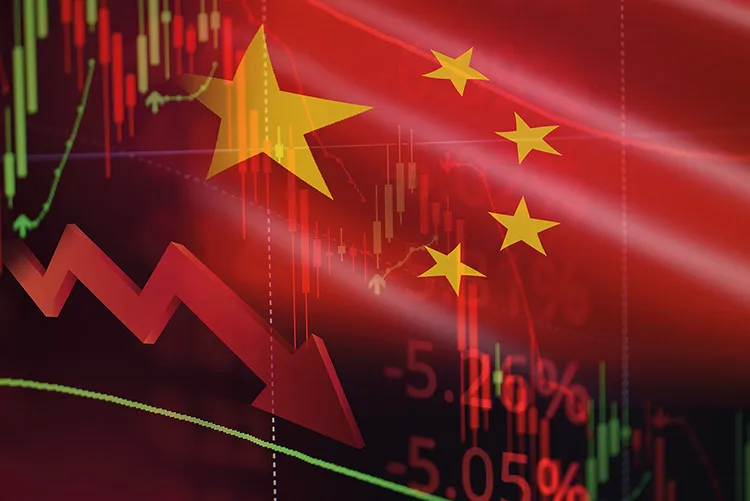

Antonio Graceffo explores whether the world’s second-largest economy can maintain its momentum in the face of major structural crises
Bilateral trade between the USA and China has plummeted in the wake of President Trump’s new 145 per cent tariffs on Chinese imports. Manufacturing activity in China has fallen to its lowest level since December 2023, and new export orders have hit their weakest point since December 2022. Unlike other countries, China has been excluded from the administration’s 90-day tariff pause – ensuring that the trade war will persist.
Since President Trump began his second term, the economic relationship between the two countries has sharply deteriorated. China’s rise from one of the world’s poorest nations in the late 1970s to the world’s second-largest economy by 2010 was remarkable, but its momentum has slowed significantly over the past decade. The last time China recorded double-digit GDP growth was 15 years ago. In contrast, last year China’s GDP grew by only five per cent. While this exceeds growth rates in developed countries such as Canada, France, Germany and Japan – many of which fluctuate between zero per cent and 1.7 per cent or even dip into negative territory – it remains a far cry from China’s past performance.
The downturn began during Trump’s first term, when he imposed sweeping tariffs on Chinese products and tightened restrictions on Chinese investments. It continued under President Biden, who retained most of the Trump-era tariffs while introducing new measures, such as the CHIPS and Science Act and expanded export controls. The slowdown was further exacerbated by Beijing’s prolonged COVID lockdowns, which lasted until late 2022.
In anticipation of a renewed trade war, Xi Jinping’s government implemented several measures to counter the impact of a second round of US tariffs. At a Politburo meeting in April 2025, Chinese leaders pledged to boost domestic demand by increasing unemployment insurance, supporting low- and middle-income earners, and expanding fiscal stimulus. They also committed to strengthening financing for struggling businesses, accelerating urban renewal projects and developing a new property ownership model. Additionally, Beijing began selectively exempting certain US goods, such as semiconductors and medical equipment, from its retaliatory tariffs. Yet the central question remains: can China withstand another trade war, given its structural weaknesses – collapsing real estate market, huge public debt, an ageing population, and more than a decade of slowing growth?
On the plus side, the sheer size of China’s population – 1.4 billion – and its GDP of US$18.77 trillion have helped it become the world’s largest trading nation and top manufacturer, running a huge trade surplus of US$992 billion in 2024. This scale makes China a formidable opponent in any trade war. Its vast industrial base, combined with an autocratic system of governance under Xi Jinping and the Chinese Communist Party (CCP), enables the leadership to command the country’s production and direct investment according to the latest Five-Year Plan. Centralised control allows the CCP to mobilise its state-owned enterprises, deploy US$3.24 trillion in foreign exchange reserves, and manage its enormous labour pool with speed and efficiency to achieve national objectives.
Another key advantage in Beijing’s arsenal – and one of the core reasons behind the trade war – is its long-standing strategy of restricting foreign investment while shielding domestic companies through tariffs and subsidies. These protectionist policies have enabled state-favoured firms to grow into global giants, including Huawei in telecommunications, CRRC in rail manufacturing and CATL in battery production. With no political opposition and the CCP firmly entrenched, there’s little indication this approach will change any time soon.
Despite China’s industrial power and centralised control, one of the system’s core weaknesses is low per capita income. China’s per capita GDP stands at about US$13,800. This is higher than most developing countries, but far behind developed nations such as the USA (US$89,000), Germany (US$55,800) and Canada (US$53,000). Income disparity remains severe. With a median per capita disposable income of just US$2,411 annually, half of China’s population is effectively poor, while roughly 12 per cent live on less than US$7 a day.
These low earnings make it difficult for China to shift away from an export-led model towards a consumption-driven economy. In developed economies, rising consumption typically marks the transition to post-industrial growth, with countries such as the USA seeing consumption account for nearly 70 per cent of GDP. In contrast, private consumption in China remains low, at just 39 per cent. For years, Xi Jinping has pledged to rebalance the economy away from investment and exports towards domestic consumption, but that transition has yet to materialise – largely because much of the population simply can’t afford to spend more.
An analysis of China’s GDP composition underscores this challenge. Services account for only 55 per cent, manufacturing 26.2 per cent and exports 18.9 per cent. While China’s heavy reliance on manufacturing and exports has driven decades of rapid growth, it also leaves the country vulnerable to external shocks – especially from the USA, its largest trading partner. When foreign demand slows or tariffs are imposed, China feels the impact immediately.
China’s rise was fuelled by low-cost, labour-intensive manufacturing, which still accounts for 91.9 per cent of its exports. In 2024, Chinese factory workers earned just US$3.87 per hour on average, compared to US$19.20 in Germany. Disposable incomes in rural China are even lower, often around US$260 per month, making factory jobs in the cities attractive by comparison. But now, factory orders are declining and job opportunities are disappearing. China’s nearly 300 million migrant workers, who leave rural areas to work in cities, are increasingly returning home empty-handed, as employers face shutdowns and fear further closures.
Officially, China’s unemployment rate stands at 5.2 per cent – only slightly above Beijing’s five per cent target. However, youth unemployment is nearly 17 per cent, and 12.2 million new university graduates are about to enter the labour force next month. Worse still, the official figures don’t account for jobless migrant workers, masking the true scale of labour market distress.
Beyond the labour market, China faces a range of entrenched structural problems that threaten long-term stability – chief among them, debt and a collapsing real estate sector. Local government debt, including hidden liabilities, is estimated to approach 120 per cent of GDP. When combined with public and private borrowing, China’s total debt burden exceeds 350 per cent of GDP. The property crisis has already wiped out nearly US$18 trillion in household wealth, with home prices down 30 per cent from their 2021 peak. The sector’s contribution to GDP has fallen from 24 per cent to 19 per cent. While this collapse dominates headlines, the more enduring threat is the underlying debt, much of it tied to non-productive investment. Major developers such as Evergrande and Country Garden have already collapsed, and the broader property market remains unstable. Shadow banking and infrastructure overspending continue to pose systemic risks. Meanwhile, foreign direct investment has declined by at least 30 per cent since 2021, and retail sales remain weak, undermining efforts to boost domestic demand.
Compounding these challenges is a demographic crisis. Only 68.6 per cent of China’s population is of working age, the median age has reached 40, and the share of retirees continues to rise. With falling birth rates and a shrinking labour force, it will become increasingly difficult for China to sustain economic growth and support its ageing population.
China isn’t collapsing, but it’s no longer surging. The era of high-speed growth is over, and the country now faces a convergence of structural challenges – from ballooning debt and a fragile real estate sector to a shrinking workforce, weakening consumption and slowing productivity. The advantages of catch-up growth are fading and rising tensions with the West are hindering technological advancement. Producer prices have been falling for two years and consumer prices are now declining as well, deepening deflationary pressure and increasing the real burden of debt. Economists forecast just 4.5 per cent GDP growth in 2025. Without a broad, coordinated stimulus, China’s economy appears headed for long-term stagnation.
Compounding these pressures is the loss of the USA as a key export market. President Trump’s tariffs, along with measures to block indirect trade through Canada and Mexico, have further eroded China’s external revenue streams. While growth may still outpace that of Europe, it will likely fall short of China’s own ambitions. Though China is growing faster than the USA, the American economy remains significantly larger. At current rates, China is only closing the gap slowly – and may take decades to catch up, if at all. The state’s ability to maintain prosperity while tightening political control is increasingly uncertain. The lower-income half of the population, especially the hundreds of millions of rural migrant workers who rely on factory jobs, will face even fewer opportunities to escape relative poverty. Whether China can avoid the middle-income trap depends on its capacity to achieve long-term productivity gains amid mounting internal and external constraints. For now, its dream of overtaking the USA as the world’s leading economic power appears more distant than before – and may never materialise.




